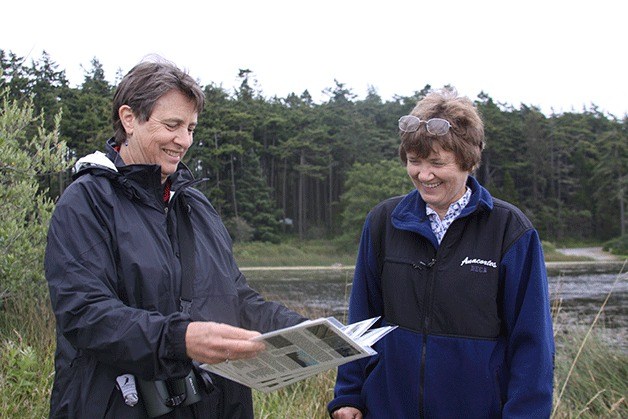As she took a quick inventory of the critters she catalogued at Deception Pass State Park, Mary Jo Adams stopped at the photograph of a skinny beetle-shaped bug.
“Who knew there were fireflies here?” Adams said with a tone of delight, pointing to an image of a diurnal firefly. “But they don’t glow.”
The firefly is one of 348 creatures, plants and fungi detailed in the recently published “Nature Guide to Deception Pass State Park and Surrounding Areas.”
The laminated nature guide is the product of a project led by Adams and Sarah Schmidt, who both live on Whidbey Island.
Although the idea of such a guide was discussed years ago, Adams decided it was time to act on it while taking pictures during a hike at the park a year and a half ago.
“So many people pass through here,” Adams said of Deception Pass, the state’s busiest state park with about 2 million visitors per year. “I see people hiking trails all the time and going from Point A to Point B and never slowing down to see what’s along the trail.”
The guide is designed to encourage visitors to pause and look closer at the natural things around them. It also arms them with a protected, educational tool that can be taken into the woods while exploring.
It’s not a pocket-sized book. It is comprised of eight double-sided sheets laminated in a plastic covering and connected together by only a plastic tie.
The Deception Pass guide is the third nature guide produced by Periwinkle Press, a small nonprofit publishing corporation based in Adams’ Oak Harbor home.
The first two guides on seaweeds and intertidal intertebrates were spearheaded by the late Jan Holmes as tools to assist in Washington State University/Island County Beach Watcher intertidal monitoring and eelgrass studies as well asfor the common beach visitor who wanted to know more about what they were observing.
The first guide, “Common Intertidal Invertebrates of the Salish Sea,” came out in 2004 and has sold about 2,500 copies. It was followed two years later by “Common Intertidal Seaweeds and Seagrasses of the Salish Sea,” which has sold about 1,500 copies. Both guides have been updated since their initial releases.
“It was her vision,” Adams said of Holmes, who passed away in December of 2011 after a long fight with cancer. “She was a real renaissance (woman).”
Adams said she and Holmes used to talk about tackling a guide on Deception Pass State Park and its diverse habitat. Holmes was so passionate about the intertidal monitoring program that she went back to college to gain a master’s degree in marine biology.
After Holmes died, Adams partnered with Schmidt, who has an extensive biology background, to take on the Deception Pass project.
“Mary Jo really handled about 99 percent of this,” Schmidt said, adding that she was tasked with proofreading.
Adams, a former nurse who took most of the photos in the guide, would have none of that talk.
“Without Sarah’s input and others’ input, this whole thing would have turned into a sorry mess,” she said.
Schmidt and Adams spoke kindly of the help provided by assistant park manager Rick Blank and of the many experts in specific areas that assisted in the project. Melissa Duffy helped roam the park to identify the various fungi and molds, which got a full page in the guide.
Among the molds found in the park is a yellow frothy variety, Fuligo septica, more commonly known as dog vomit slime mold.
During her countless trips to the park, Adams came across many more pleasant discoveries.
She and Schmidt encountered a pair of American Minks near Cranberry Lake.
There were also surprises such as two large, white roosters spotted on the Pass Lake trail.
“They didn’t fit into the guide,” Schmidt joked.
The guide includes mammals, birds, reptiles, amphibians, insects and the many trees, shrubs and plants found in and around Deception Pass State Park and surrounding areas.
Most photos in the guide were taken of critters and plants at the park. Some were taken in other areas on and around Whidbey by contributing photographers such as Whidbey nature photographers Craig Johnson and Jill Hein.
A college professor from Western Washington University, dragonfly expert and butterfly association were among the expert eyes that also contributed.
Adams said she was also grateful for the island’s library system, which provided books to help her with research to provide park visitors with what she hopes will be a helpful resource.
“We like to get people more connected with nature,” Adams said. “That’s really nice because I think people have lost that.”
HOW TO ORDER
The “Nature Guide to Deception Pass State Park and Surrounding Areas” is selling for a suggested retail price of $22 with profits benefitting the park and the Orca Network. The guide may be found at the main entrance to the park. The Orca Network also is handling distribution of the guides at the Langley Whale Center. In central Whidbey, Lavender Wind Farm also has copies for sale.



